#James A. Garfield National Historic Site
Text
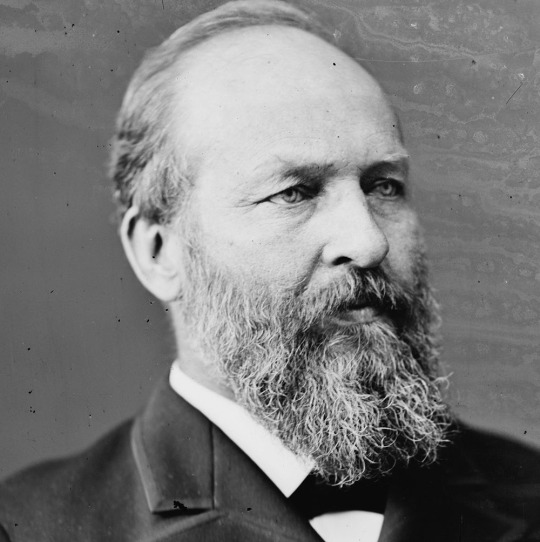
I had always thought of James Garfield as a broad man, not exactly plump, but full and hearty. I had known that his long period of wasting away had been what killed him, but upon visiting the James A. Garfield National Historic Site in Mentor, Ohio, I saw his death mask. I was shocked to see how much of him was gone.
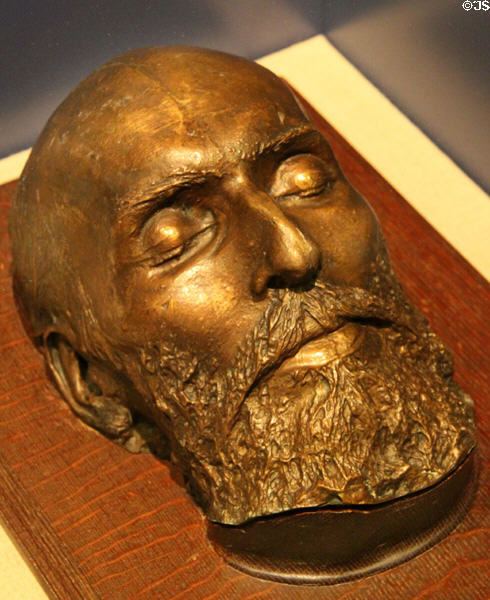
#not my photo#James A. Garfield National Historic Site#I would recommend visiting if you're ever in Ohio#Garfield#James Garfield#President Garfield#Presidents#History#Presidential History#Death Mask
10 notes
·
View notes
Text
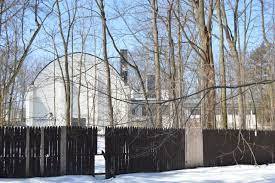
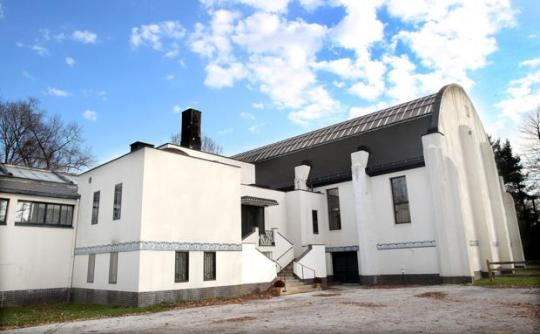

The Hangar Recreation Association
24400 Cedar Rd.
Beachwood, OH
The Hangar, a private recreation center, was built in 1930 as part of the Dudley S. Blossom estate, in what was then Lyndhurst but is now Beachwood, Ohio. Many estates and country houses of that era incorporated a private sports facility, as a place where children, their friends -- and adults -- could swim and play tennis indoors. From the outside, this Cleveland version of a private recreation center does partly resemble an airplane hangar -- because of the two glass-pitched roofs, one each over the tennis court and swimming pool. The plain stucco exterior evokes Art Moderne. Its architect was the highly regarded Abram Garfield, whose father, James A. Garfield, served briefly as the 20th president of the United States before dying in 1881 of wounds from an assassin's bullet. The Hangar shows the fluency that Abram Garfield had. It was the only Art Deco building Garfield would ever create.
Dudley Blossom was a successful Cleveland businessman, but he and his wife are more widely known for their philanthropy, in particular their support of the musical arts. Elizabeth Blossom -- nee Bingham -- was the sister of Frances Payne Bolton, who was married to Chester Bolton, a congressman whose seat Frances would fill upon his death. The Bolton and Blossom estates took up hundreds of acres of the land adjacent to what is now Cedar and Richmond roads. The Blossoms, best known today for the amphitheater named for them in Cuyahoga Falls, the summer home of the Cleveland Orchestra, had a longtime friendship and professional relationship with Abram Garfield.
Garfield, who would found the school of architecture that would be enfolded into Case Western Reserve University, had designed many other homes, including the Mather House at CWRU and the Hay-McKinney Mansion of the Western Reserve Historical Society. He had also designed the Blossoms' Tudor Revival home in Lyndhurst, which was built about a decade before the Hangar was added. The Hangar was his first foray into the design style that had swept the world since the 1925 exhibition in Paris of "arts decoratifs." That exposition debuted a modern style characterized by a streamlined classicism, and geometric and symmetrical compositions. Its prominent motifs often included stylized animals and Aztec or Egyptian references (the latter inspired by the mania surrounding the 1922 discovery of King Tut's tomb).
The Hangar is not open to the public. Today, it is owned by Charles Bolton, whose great-aunt was Blossom's wife, Elizabeth. It is Bolton who oversaw its restoration in the mid-1980s, which was around the same time that the Hangar was listed on January 9, 1986, with the National Register of Historic Places. The Hangar's glory resides in its interior. Guests who arrive in the main lounge are immediately surrounded by a vivid, sea-themed wall mural that leads upward to a sapphire-glass tray ceiling, from which hangs a sleek, silvery chandelier. The mural is signed "June Platt, 1930." Platt's mural at the Hangar shows a mastery of detail and imagination. Sea anemones, guppies, zebra fish and other samples of fantastical marine life swirl in pinks, mint greens and soothing blues, in forms both bold and delicate.
In the 1970s, the membership rolls of the private Hangar Recreation Association read like a who's who of Cleveland's East Side, including names such as Burton, Meacham and Dempsey. Even Sherman Lee, the director of the Cleveland Museum of Art, was an avid tennis-playing member. During the restoration, the Boltons (Charles' wife, Julia, was also greatly involved) salvaged small pieces of wallpaper from protected areas and then had a specialty firm in Cincinnati re-create the original design, using a silk-screen process. The result: walls papered with vintage designs in saturated hues. Today The Hangar is the occasional site of a wedding or a member's private party.
0 notes
Text
Could prefab homes solve Canada’s housing crisis? ‘It’s like an orchestra’
Canada is facing a housing crisis — the number of homes needed in the country keeps growing but not the number of people needed to build those homes. As homebuilders and policymakers grapple with this problem, some may find answers in “prefabricated” houses, according to experts.
“Prefabricated (or prefab) housing is a form of housing where the building blocks are built in a factory rather than on-site,” Matti Siemiatycki, director of the infrastructure institute at the University of Toronto, told Global News.
“By manufacturing in a factory, it means construction can be done more precisely and it saves energy costs,” he said. Not being constructed on-site also saves labor costs, Siemiatycki added.
Prefab homes have been quite the rage of late. This is from tiny homes being flaunted on Instagram to being the popular choice for an Airbnb stay, to Elon Musk living in one himself.
As of last year, the billionaire was known to be residing in Boca Chica, Texas, in a 375-square-foot, energy-efficient prefab home from the company Boxabl. The model of home, known as the Casita, starts at around US$45,500 and is delivered to the customer on the back of a semi-truck.
Some companies, like Roombus, are even integrating software into their designs to make smart prefab homes. Roombus’ Nest homes are equipped with the company’s RoomOS software that can be used to unlock your house, adjust the lights and control the climate — all with a phone.
Prefab homes have been popular in waves throughout history, like in the U.K. after the Second World War following a housing shortage, according to Siemiatycki.
“There’s a long history of prefabricated homes. You used to be able to buy them from a Sears catalog,” said Siemiatycki, who is also a professor of geography and planning at the University of Toronto.
Between 1919 and 1928, Sears, Roebuck & Company sold home kits from its “modern home program,” according to the James A. Garfield National Historic Site. One home was even named “The Garfield” after the 20th president of the United States.
In Canada, many houses are typically built using the “stick construction” method — in contrast to prefab homes, where the home is delivered after it’s constructed, according to Siemiatycki. It is a construction method in which materials are assembled on-site.
“Interestingly, we’re returning to (prefab) now because we’re in a housing crisis,” he said. “You’re hearing a lot of emphasis on prefab housing, and it’s becoming more popular.” With increased demand, there has been a rise in companies creating prefabricated homes, though one hasn’t exactly dominated the market as of yet, said Siemiatycki.
“These companies have struggled to find a foothold. There’s a lot of talk about this. However, if this is going to catch on, who’s going to become the dominant player is still really up for grabs,” he said.
For 28-year-old Sasha Weekes and her boyfriend, moving into a 608-square-foot prefab home in central Prince Edward Island helped to “cut our expenses back by a lot.” “On the East Coast, they’re quite common, especially now with the housing crisis,” she told Global News.
Weekes’ home qualified for a mortgage through Canada Mortgage and Housing Corporation. The biggest hiccup, however, was the delay Weekes faced in actually getting her prefab home delivered amid construction setbacks.
“People think that a prefab house will be a quicker option, but you have to do a lot of site preparations and then you have to wait for the house to be built and you have to wait for it to come,” she said.
When her home finally did arrive, two months were spent getting the septic dug and electrical installations done, before they could move in. “I think a lot of people around our age on the East Coast that have been priced out have had to use this option,” she said.
“They’re built well, and they are a better option (price-wise),” she said, but one must be prepared for the wait. Part of the solution to Canada’s housing crisis could be an increase in supply and according to Siemiatycki, “this is where prefab housing can have a big opportunity.”
Prefab homes can be constructed faster than regular houses, according to Adam Dumond, designer at Royal Homes in Ontario. “It’s like an orchestra,” he told Global News. “The home is built pretty much all at the same time. Framing, windows, and roofing — all of that can be done simultaneously in a manufactured prefab home.”
“It’s a cool alternative to stick framing. The crews are happy your home is indoors being built while the weather’s doing whatever it’s doing,” Dumond added. After the house is constructed, it is delivered in modules to the customers’ property to be assembled.
“A crane comes in and then we pick the home up and put it on the foundation one module at a time,” Dumond said. On average, Royal Homes sees about two and a half modules per house for something in the 1600-to-1800-square-foot range. Each square foot ranges roughly between $350 and $450, depending on where you live, said Drumond.
That means a 1,600-square-foot home could cost between $560,000 and $720,000 and an 18,00-square-foot home, somewhere between $630,000 and $810,000. “We have some homes that are a little bit less (in price) and some homes that are a little bit more. It just really depends on where you want to build,” he said.
In Ontario, the average price of a home sat at $829,934, as of Nov. 2022, according to the Canadian Real Estate Association. Though a prefab home may be cheaper than the average price of a home in the province, purchasing land for it to perch on is also a factor that needs to be considered.
“Every site is a little bit different,” said Dumond. It is necessary to be mindful of properties near water-shedding areas or rock formations, he cautioned. Siemiatycki agrees. “We need to be very careful that people are not buying in places that are prone to flooding or prone to wildfires. We need to be very careful that we’re not building in low-lying areas or areas that are right at the urban wildlife interface.”
In Ontario, nearly two-thirds of residents spend over 30 percent of their household budget on housing, according to a recent poll from the Ontario Real Estate Association (OREA).
Despite the rising cost of living putting pressure on Canadians, seven in 10 non-homeowners in Ontario identify as someone who “really wants to own a home,” the poll found.
And in Ontario, as well as B.C., high-interest rates are expected to continue to hold back homebuyers into the new year, according to a recent report from RBC. When it comes to architecture and design, prefab homes tend to be “repetitive,” according to Siemiatycki.
Putting personal touches on a home can also prove tricky. “There’s always a trade-off with prefabrication about how much customization you want to do before you lose the benefits — the economies of scale of building it in a factory,” said Siemiatycki.
For prefab homes to make their mark on Canada’s housing market, it is necessary to ramp up production, Siemiatycki said. “If a part of the supply is going to be provided by modular, either for single-family homes or multi-units, there’s liable to be a need for a huge amount of capacity in the market that isn’t even available right now,” he added.
Durability can also differ when it comes to prefab homes, according to Siemiatycki. “It does vary depending on how it’s built and what its lifespan is estimated to be,” he said. They need to have a history of being sustainable in places “vulnerable to environmental conditions.”
“We continue to need proper planning and making sure that where we’re building is safe to build and it’s not vulnerable because otherwise, you’ll just be creating real further challenges down the road for everyone involved — the municipalities, the first responders, and for the people that are ultimately living in these homes,” he said.
It’s wise to look for a reputable company, according to Siemiatycki. “This is thinking through (not just) who’s manufacturing, but also who’s assembling it,” he said.
Also thinking about whether the property can be rented out or resold down the road is something to be mindful of, Siemiatycki added. “There’s a lot of research that is involved in buying a home. For many Canadians, this will be the largest purchase they make in their life,” he said.
0 notes
Photo

#poe #edgarallanpoe #edgarapoe #davidkeltz #theraven #mvaldemar #thefactsinthecaseofmvaldemar #dayoff #tourlife #roadtrip (at James A. Garfield National Historic Site) https://www.instagram.com/p/Cj9UbbErpBx/?igshid=NGJjMDIxMWI=
#poe#edgarallanpoe#edgarapoe#davidkeltz#theraven#mvaldemar#thefactsinthecaseofmvaldemar#dayoff#tourlife#roadtrip
0 notes
Photo
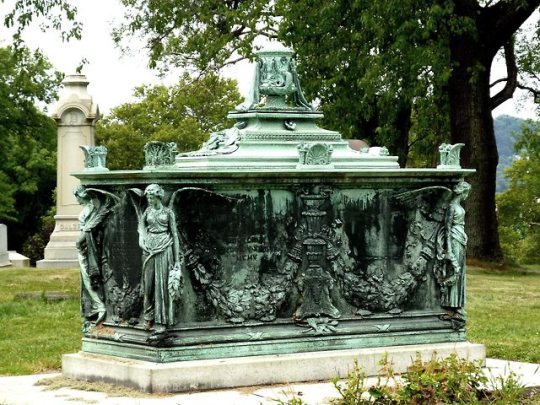
James B. Oliver Monument
Allegheny Cemetery
Allegheny Cemetery is one of the largest and oldest burial grounds in Pittsburgh, Pennsylvania, USA.
It is a nonsectarian, wooded hillside park located at 4734 Butler Street in the Lawrenceville neighborhood and bounded by the Bloomfield, Garfield, and Stanton Heights areas. It is sited on the north-facing slope of hills above the Allegheny River.
In 1973 the cemetery's Butler Street Gatehouse was listed on the National Register of Historic Places and in 1980 the entire cemetery was listed on the National Register.
#cemetery#cementerio#cimetiere#cemiterio#burial ground#coffin#monument#grave#tombstone#graveyard#angels#sentinels#the guardian ang#allegheny cemetery#mourning#memento mori#taphophilia#taphophilie#silence#sark place#gothic place#usa#pennsylvania#pittsburgh
20 notes
·
View notes
Photo

Got this from someone who isn’t on IG. I have had a slow start to writing in January. Dunno why. Maybe with my office being refreshed I’ll be more motivated. (at James A. Garfield National Historic Site) https://www.instagram.com/p/CKWJ0Y3gpUs/?igshid=4i2nlpq82i1n
0 notes
Text
Inquiring Minds: Alan Gephardt, Garfield Expert
Inquiring Minds: Alan Gephardt, Garfield Expert
By Wendi Maloney
Published October 07, 2019 at 10:30AM
Alan Gephardt is a ranger at the James A. Garfield National Historic Site of the U.S. National Park Service in Mentor, Ohio. He has drawn extensively on the James A. Garfield papers at the Library to interpret the 20th U.S. president’s legacy.
Alan Gephardt holds a reproduction of one of President Garfield’s scapbooks. Photo courtesy of the Garfield National Historic Site.
What does your job entail?
My principal duty is to explain the life and career of James A. Garfield to the public. This involves giving tours of the Garfield home, giving talks at the local library and other nearby venues and writing blog articles relating to Garfield and his times. These duties require reading and research.
What is your background?
I have always been interested in U.S. history and presidential history in particular, so working at the Garfield site has been very gratifying. I am a native of Maryland and have a bachelor’s degree from Towson University and a master’s degree from the University of Maryland Baltimore County. I have worked in the museum field since 1990, mostly in Baltimore. In 2007, I became an employee of the National Park Service. I have worked at the Hampton National Historic Site in Towson and the Fort McHenry National Monument and Historic Shrine in Baltimore. I started at the Garfield National Historic Site in 2009.
Tell us about your research at the Library.
My most recent Library project was creating facsimiles of the leather-bound volumes of the president’s papers, now held in the Library’s Manuscript Division. They originally resided in a fireproof vault in the memorial library at the Garfield home in Mentor, Ohio. Mrs. Garfield built the library onto the house in 1885 and called the vault the Memory Room. She had the papers organized topically and chronologically and bound in red, green, black and brown leather with gilded lettering and designs. The collection consisted of more than 200 volumes of letters, scrapbooks, bound newspapers, diaries, plus military and academic records. In 1931, the Garfield children began to donate the collection to the Library.
Recently, I started a project to re-create the bindings for display at the Garfield site. Facsimiles of the originals, I thought, would give visitors a better sense of the extent of Mrs. Garfield’s effort to lovingly preserve her husband’s papers.
I contacted Michelle Krowl of the Manuscript Division for permission to measure a selection of 70 of the volumes, making notations on the wording and designs on each spine. Initially, I had the privilege of performing this task in the Manuscript Reading Room over several visits, but then Michelle and I worked together one day and knocked out the task of measuring and transcribing. With all of this information in hand, I worked with the Cleveland-based Esper Bindery to make the facsimiles that now fill two full shelves in the Memory Room, with a little spillover onto another shelf. Everyone who has seen them has been well pleased with the result.
How else have you used the Garfield papers?
I first began visiting the Library in 2014 to use of the papers of Lucretia Garfield, President Garfield’s wife. I was particularly interested in the many condolence letters that she received in the wake of her husband’s death by assassination — hundreds from people from all walks of life in the U.S. and overseas. I drew on the letters and Mrs. Garfield’s papers for public presentations. But the papers also led me to an unexpected discovery. About two years ago, I stumbled on correspondence with the Wooton Desk Company of Indianapolis that revealed the origins of the secretary desk in the memorial library of the Garfield home. The correspondence made it clear that Mrs. Garfield had the desk made in 1882. Nothing much had been known about it before then. Without the opportunity to consult Mrs. Garfield’s papers, this intriguing, though admittedly minor, bit of the Garfield story would not be known.
How would you describe the value of the Garfield papers generally?
Obviously, the papers of President Garfield, and those of his wife and children, also preserved at the Library, are a resource of immense value to those of us who work at the Garfield National Historic Site and, by extension, to our visitors. They provide so many insights into Garfield’s personal and professional relationships, the issues with which he contended, the cultural currents of his day and the lives of his wife and children after his tragic death. Since the Library made the papers available online this summer, I have looked at reminiscences of Garfield’s older brother, Thomas, about Garfield; the correspondence of one of Garfield’s secretaries, George Rose; and some of the diaries of Garfield’s mother. In every case, something has been revealed that adds context to my understanding of Garfield’s life. The entirety of the Garfield papers is an invaluable asset to the National Historic Site and to the American public.
Subscribe to the blog— it’s free! — and the largest library in world history will send cool stories straight to your inbox.
Read more on https://loc.gov
0 notes
Photo

Lawnfield, Mentor, Ohio - Keeping with the Presidential theme of my last couple of posts, I stopped in at President James Garfield's estate, deemed "Lawnfield" by reporters. While serving in the U.S. House of Representatives, Garfield purchased this place to accommodate his growing family. The house and especially the porch became famous during his presidential campaign. Instead of traveling the country, Garfield gave speeches from this front porch. A nearby railroad stop gave people easy access to the home and they showed up in droves. The strategy paid off when he won the election of 1880. Sadly, he was assassinated by an angry supporter and never had a chance to achieve much as President. #MikeDoesHistory #history #education #travel #roadtrip #home #Garfield #President #POTUS #politician #Lawnfield #porch #frontporch #campaign #instahistory #historygram #adventure #historymarker #historystop #likemike #historical #Ohio (at James A. Garfield National Historic Site) https://www.instagram.com/p/Bvf5jo_ApI8/?utm_source=ig_tumblr_share&igshid=1snwkjb6bw8zs
#mikedoeshistory#history#education#travel#roadtrip#home#garfield#president#potus#politician#lawnfield#porch#frontporch#campaign#instahistory#historygram#adventure#historymarker#historystop#likemike#historical#ohio
0 notes
Text

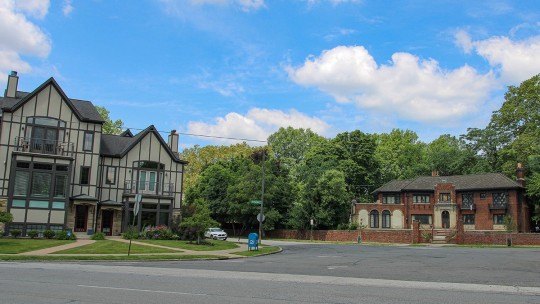
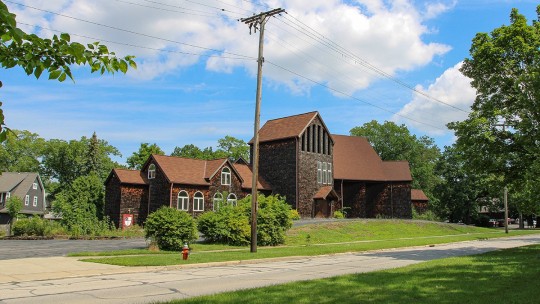

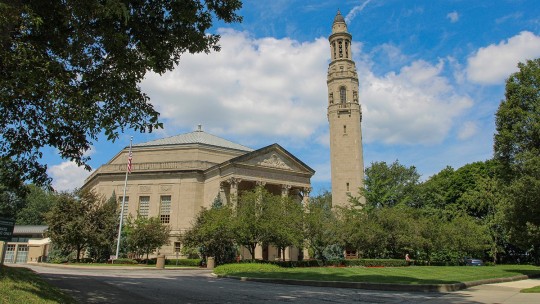


Euclid Heights Historic District
2729-2611 Edgehill Rd.
Cleveland Heights, OH 44106
Unlike other National Register Districts in Cleveland Heights, which are exclusively residential and exclusively single-family, the Euclid Heights Historic District's building types and architectural styles create a rich portrait of American upper and middle-class lifestyles during the late 19th and early 20th centuries. This 365-acre suburb bounded by Mayfield Rd., Coventry Rd., Cedar Rd., and Overlook Lane, was one of the first platted in the desirable higher ground located along an escarpment above Cleveland's University Circle and Euclid Avenue. Early on, Euclid Heights’ developers sought to attract wealthy Millionaires’ Row residents who, in the late 19th century, had begun migrating eastward away from the city's pollution and commercial bustle. The development benefited from the advent of electrified streetcars, which could conquer the steep grades leading up to the Heights. Tucked in the corner of a green space framed by Doan Brook and Lake View Cemetery, Euclid Heights offered a stylish retreat where those able to handle longer commutes could enjoy spacious lots, curving streets, handsome architecture, spectacular views, fresh air, privacy and a chance to put distance between themselves and the increasingly dirty, problem-plagued city below.
The story goes that Atlanta and New York railroad lawyer Patrick Calhoun, grandson of U.S. Vice President and Senator John C. Calhoun, traveled to Cleveland on business in 1890. Having time to spare, Calhoun rode out to Lake View Cemetery to see the recently dedicated memorial to the slain President James A. Garfield, a structure Calhoun’s family had supported. On the way he noticed the building boom going on in the East End (Hough area), and wondered where that was heading. Calhoun had been involved earlier in the Richmond Terminal railroad project in Virginia and was familiar with the groundbreaking work that Frank Sprague, the "Father of Electric Traction," had done there in using electric railroads to promote urban development. Knowing that the East Cleveland Railway Company had recently done some innovative work electrifying streetcars locally, Calhoun saw an opportunity to develop an important streetcar suburb at the top of Cedar Glen.
Working with local partners, including John D. Rockefeller's real estate man, J.G.W. Cowles, attorney William Lowe Rice and merchant John Hartness Brown, Calhoun had development plans drawn up by 1892. The Panic of 1893 put their plans on hold but by 1896 an amended site plan was recorded—more or less identical to today's layout of the area with Euclid Heights Boulevard bisecting the site from the southwest corner at the crest of Cedar Hill. In the northeast corner of the development would be the commercial district, what we now know as Coventry Village. Other prominent features included The Overlook—Overlook Road southwest of Edgehill Road and featuring large mansions featuring splendid north- and west-facing views—and the Euclid Club, a country club that sported a golf course spanning both sides of Cedar Road and a grand quarter-mile entry path beginning at what is now the corner of Derbyshire and Surrey Roads.
The development gradually attracted fine homes and also spurred other beautiful subdivisions, such as Barton Deming’s Euclid Golf Allotment on the south portion of the former golf course (which closed in 1912). Moreover, the Van Sweringen brothers, are believed to have been paperboys in the Euclid Heights area and later went on to adopt themes from the Euclid Heights Allotment in their famous Shaker Heights and Shaker Farm communities (the latter comprises streets such as Stratford, Marlboro, Fairfax and Guilford, west of Lee Road and immediately north of Fairmount Boulevard) . Calhoun, however, was distracted by legal problems running the San Francisco streetcar franchise after the Great Earthquake and saw his Euclid Heights development company forced into bankruptcy in 1914. By then William Rice had been murdered while walking home to the Overlook from the Euclid Club, a sensational case that featured John Hartness Brown as a suspect. Although it still maintains its picturesque “Garden City” look, Euclid Heights soon evolved from a private hilltop retreat to a busy gateway to the rapidly developing Heights. A large portion of Calhoun-owned land in the area’s eastern sector was sold off and subdivided, thus explaining why Cleveland Heights homes east of Coventry Road tend to be somewhat more modest than those near the top of the hill. Euclid Heights was listed with the National Register of Historic Places on October 31, 2012. It remains full of architecturally significant homes (including Calhoun's at 2460 Edgehill), but its main significance is the role it played in opening the Heights as a streetcar suburb for wealthy Clevelanders.
0 notes
Text
10 Pinterest Accounts To Follow About Cleveland
Ralphie's actual home from A Christmas Story with the Leg Lamp in the window. The Steamship William G. Mather is tied up immediately outside the Nice Lakes Science Center and available for self-guided tours. Walk up by the cargo hold to the pilot house. Youngsters can even faux to steer this 618-foot historic ship. Remember to try the engine room and engineers' quarters behind the ship. There you may be taught exactly how this steam ship was powered till it was taken out of service in 1980.
The Lawnfield property, now administered by the Nationwide Park Service, contains spacious major house, several out-buildings, and a visitors' heart with altering exhibits about Garfield's life, his presidency, and his death. The James A. Garfield Historic Web site is open each day from Could 1 via October.
Replacement window company called EZ Window Solutions of Cleveland 159 Crocker Park Blvd #400 A, Westlake, OH 44145 (440) 773-4396 and A Christmas Story House 3159 W 11th St, Cleveland, OH 44109 (216) 298-4919
THE TEN BEST Free Things To Do In Cleveland
Far more pushed-via than walked in, the Cultural Gardens alongside Martin Luther King Boulevard are a treasure of inexperienced space and cultural monuments within the metropolis. Decide a nation of interest - there are a staggering quantity represented here - park your automobile, and take all of it in on foot.
Customized Crating: There are some transferring projects which require a very specific type of packing, this packing is called crating and normally involves wooden pallet model boxing. In case you require crating to your shifting needs, Bright Eyed Transferring are geared up to assist. Contact us immediately to be taught extra about our crating services.
Town is situated on the southern shore of Lake Erie , across the U.S. Cleveland Ohio maritime border with Canada and approximately 60 miles (one hundred kilometers) west of the Ohio- Pennsylvania state border. It was founded in 1796 near the mouth of the Cuyahoga River by Common Moses Cleaveland It became a producing center due to its location on both the river and the lake shore, as well as being related to numerous canals and railroad strains. Cleveland's economy relies on diversified sectors akin to manufacturing, financial companies, healthcare , biomedicals, and better education.
0 notes
Text
How Reagan’s Childhood Home Gave Up on Reaganism
New Post has been published on https://thebiafrastar.com/how-reagans-childhood-home-gave-up-on-reaganism-14/
How Reagan’s Childhood Home Gave Up on Reaganism
Photograph by M. Scott Mahaskey
DIXON, Illinois—In the gift shop of the Ronald Reagan Boyhood Home is a T-shirt bearing one of the 40th president’s best-known sayings: “Government is not the solution to our problem. Government is the problem.” Since opening to the public in 1984, the home, run by a nonprofit foundation, has lived by that principle, rejecting public money and staying proudly independent. Its website declares, “The Ronald Reagan Boyhood Home does not receive State or Federal Funding.”
Nearly 130 years old, the three-bedroom, one-bathroom white house onSouth Hennepin Avenue in Dixon is a testament to Reagan’s modest, all-American childhood.Many of its counterparts around the country, includingBill Clinton’s boyhood home in Hope, Arkansas; John F. Kennedy’s birthplace in Brookline, Massachusetts; andthe estate in New York where Franklin D. Roosevelt was born, are run by the National Park Service.
Not Reagan’s house.In 2002, Dixon’s congressman, Dennis Hastert, then the Republican speaker of the House, passed a bill authorizing the National Park Service to buy the property and manage the house, as it does so many other presidential properties. The members of the Reagan home’s board of directors were aging and approached Hastert because they thought the Park Service might be a good candidate to carry on their work. They changed their minds, however, and spurned the help,in part because Congress wouldn’t match the millions of dollars private donors had invested in the property, and in part because that’s not how Reagan would have wanted it.
“He didn’t think government needed to be involved in our daily lives,” Connie Lange, the executive director at the time, said of the 40th president. “And people really took that to heart here.”
The Reagan boyhood home’s independence made it a rallying point for conservatives. Grover Norquist, founder of Americans for Tax Reform and the Reagan Legacy Project, told theWashington Times, “I’m not in favor of the government owning property, never mind Reagan’s house.” In a 2013 report about the “congressional shortsightedness and bureaucratic mismanagement” around U.S. national parks, Senator Tom Coburn of Oklahoma used the Reagan house as evidence that historic sites could be just fine in private hands, writing that the home had recently reported an annual net income of $172,000 and “can manage its affairs just as well as many of the nonprofits administering the nation’s celebrated presidential sites.”
Now, though, it turns out the mantle of Reaganism might be too much for Reagan’s boyhood home and his small hometown to carry.The Ronald Reagan Boyhood Home Foundation, beset by shrinking attendance, a shortage of volunteer docents, an aging house and—crucially—the death of its most generous benefactor,is finally asking the government for a bailout. And this time, it’s basically inviting Congress to name its price.
A year ago, Patrick Gorman, who became the foundation’s executive director in 2016, wrote a letter to the National Park Service, offering, at long last, to sell the home to the federal government. He understood, and sympathized with, the former president’s philosophy. But it had reached the point that clinging to Reagan’s anti-government principles might mean the demise of the most important tourist attraction in Dixon. He and the foundation were not willing to leave the home to the whims of the free market.
“It’s not gonna close, if I have to stay here and run it myself,” says Gorman, who grew up nearby in another home the Reagan family inhabited. “It would be a loss to this community, the status, the tourism. Those 5,000 people that come to see us [every year], they eat in restaurants, spend money here.”
The boyhood home would not be the first presidential property to pass from a private foundation to the Park Service. James Garfield’s Lawnfield in Mentor, Ohio; William Taft’s house in Cincinnati; Herbert Hoover’s home in West Branch, Iowa; and Clinton’s home in Hope, have all gone through the process. But none did so after such a concerted resistance, in the name of a president’s legacy. Now, a monument to private-sector gumption is becoming, instead, a testament to its limits.
***
Ronald Reagan moved intothe house at 816 South Hennepin Avenue in December 1920, when his father, an itinerant shoe salesman, finally settled down as co-owner of a store called the Fashion Boot Shop. The Reagans—including Ronald’s mother and older brother—occupied the house until 1924, first paying $12 per month in rent, then $15. Reagan would spend the remainder of his youth in Dixon, leaving at 18 to attend Eureka College downstate.
In his autobiography,An American Life, Reagan wrote that life in Dixon “was as sweet and idyllic as it could be, as close as I could imagine for a young boy to the world created by Mark Twain inThe Adventures of Tom Sawyer.” “Dutch” Reagan, as he was known in his hometown, skated on the frozen Rock River (“the Hudson of the West”), played right guard on the Dixon High School football team and launched his acting career in student theatricals. During the summers, he worked as a lifeguard at Lowell Park, where he claimed to have saved 77 swimmers, though locals will tell you a lot of those would-be drowning victims were girls who wanted to be saved by the handsome young man in the tank suit.
As even Reagan admitted, though, life in Dixon was not always sweet. Reagan’s father was an alcoholic, and the house on South Hennepin Avenue was the scene of Reagan’s darkest childhood memory. One night, when he was 11 years old, Dutch came home from the YMCA to find Jack Reagan sprawled out on the snowy lawn, dead drunk after a binge at a speakeasy. Reagan dragged him inside by the overcoat, “then put him to bed and never mentioned the incident to my mother,” he wrote in the autobiography.
The house was later chopped up into two apartments, and it stood vacant by the time Reagan ran for president in 1980. Thatyear,a mailman alerted local business leaders to its history. They pooled their money to buy the house, starting the Ronald Reagan Boyhood Home Foundation.
The Queen Anne-style home, built in 1891, would probably have been demolished long ago if Reagan hadn’t lived there. It is furnished with period beds, old-fashioned china, a Detroit Jewel stove and an icebox. The furniture, which was purchased at second-hand shops around Illinois, didn’t belong to the Reagans—though there is a chair Dutch sat in when he visited a neighbor to listen to the radio. The only feature connecting the house to its long-ago occupants is a loose tile in front of the fireplace, under which Reagan and his brother hid pennies. (A photo in the upstairs hallway shows Reagan and his brother during a 1984 visit, sitting on a replica of the bed they shared.)
Even so, in the 1990s, the home was drawing 20,000 visitors a year—only a 10th the number of visitors Lincoln’s home in Springfield draws, but enough to make it a viable tourist attraction in Dixon, a town of 16,000 people a two-hour drive from Chicago.
Author Bob Spitz says the home also was a valuable research tool, giving him a sense of Reagan’s humble background that informed Spitz’s biography,Reagan: An American Journey. “His bedroom was no bigger than a closet; it is where he often shared a single bed with his brother,” Spitz says. “The tiny porch is where he occasionally found his father passed out from a binge and had to drag him not only inside, but up a steep flight of stairs. The ‘garden’ where his mother raised vegetables so the family could eat when meat was unaffordable was no more than a patch out the back door, by the garage shed.”
The National Park Service manages 16 presidential homes, including Abraham Lincoln’s house in Springfield, Illinois, and FDR’s in Hyde Park, New York—each of which has six-figure annual attendance and could probably get by without government help. (Reagan’s Rancho del Cielo in California is owned by the Young America’s Foundation, which uses it as a center to promote conservative ideals. The Reagan Library in Simi Valley, California, which receives 400,000 visitors a year, is jointly run by the National Archives and the Reagan Foundation.) There are at least 20other presidential homes besides Reagan’s that are run by private foundations, including George Washington’s Mount Vernon, James Buchanan’s Wheatland and Andrew Jackson’s The Hermitage. Most survive on a mixture of tourist dollars and local investment.
But among presidential attractions, childhood homes like Reagan’s are not in the same league as Mount Vernon or Thomas Jefferson’s Monticello. The best known—JFK’s birthplace in Brookline, Massachusetts—is a Park Service property that receives about 25,000 visitors a year, less than a 10th of the traffic at Kennedy’s presidential library in Boston.
It doesn’t help the Reagan home that Illinois is not the state most Americans associate with the 40th president, and Dixon is not a major population center. The town also doesn’t have much to offer visitors other than Reagan. (It does have a lot of Reagan, though: a History and Learning Center; Reagan statues; a Reagan museum; his original lifeguard chair. There’s also a Ronald Reagan Middle School.)
“It has less to do with presidencies and more to do with the tourist business,” says Hugh Howard, author ofHomes of the Presidents. “If you go to Charlottesville, which is a fun place, you can’t not go to Monticello.”
***
One of the main reasons the boyhood homefoundation could maintain the Reaganite principle of independence from government for so longwas Norm Wymbs, a Florida grocery store magnate who knew Reagan personally and was the home’s biggest benefactor—a “sugar daddy,” in the words of staffers and board members. Wymbs idolized Reagan—he even wrote a book about the president’s years in Dixon—and spent $5 million to restore the house to its 1920s look and build a visitor center. Shortly before his death, he deeded a home he owned in Dixon to the foundation, which sold it in 2013 to a private buyer for $270,000 (the source of the $172,000 profit cited in Coburn’s 2013 report, according to a foundation board member).
That money was used to purchase four small houses near the boyhood home as part of a since-abandoned expansion plan. Wymbs—who called Hastert’s 2002 allocation of $420,000 to buy the home “insulting,” because it didn’t approach his investment over the years—died in 2016, leaving the Reagan home to support itself.
As Reagan has receded into history, attendance has fallen to 5,000 visitors per year. In 2016, finding the home in a state of decrepitude, Gorman took out a $100,000 line of credit. A retired nuclear power plant mechanic, Gorman went a year without taking a salary, but the home was still losing $20,000 to $25,000 annually. Although a pair of $25,000 donations from a local charity will help pay off the line of credit, no one has stepped forward to replace the home’s sugar daddy. Last year, Reagan’s post-presidential secretary, Peggy Grande, came to Dixon for a fundraiser; it netted only $7,500.
When Gorman told the board of directors that he was seeking a Park Service takeover, this time, there was no pushback. Everyone realized the home could no longer raise enough money to remain open.
“It’s the only move,” says Joe Rudolphi, the board’s treasurer. “I don’t think we have much choice, unless we can find someone in Chicago to support us. We need to put a new roof on the house. That’s going to cost thirty, thirty-five thousand dollars. You look at an old house, an old property—it’s a money pit.”
Hastert’s act of Congress establishing a Ronald Reagan Boyhood Home National Historic Site is still in effect, but the appropriation to buy the house has expired. The Park Service is aware of the foundation’s desire to sell, and is working to arrange for an appraisal, says Brent Everitt, a spokesperson for the National Park Service: “Once the due diligence process is completed, the NPS would likely begin the process of developing a land acquisition budget request through Congress.”
Dixon’s current congressman, Adam Kinzinger, a Republican, “supports the National Park Service purchasing the site,” he said through a spokesperson. This time, the money to honor Reagan will have to come from a Democratic Congress. One factor in the home’s favor, however: The Park Service can name its own price.
“Whatever we can get, I would recommend that we take,” Rudolphi says. “If we can get out of there, just get. We can use the money to help kids through college, give them a Reagan scholarship, help the people in the community.”
In the meantime, the Reagan boyhood home soldiers on, with dwindling resources and visitors. Gorman says he has “mixed emotions” about selling the anti-big government president’s house to the government. (Although maybe he shouldn’t: Despite Reagan’s rhetoric, the Park Service acquired plenty of land when he was president, including an $8 million purchase in the Santa Monica Mountains.) But Gorman believes it’s the best way to honor Reagan. As it stands, Gorman is the home’s only full-time employee. He has trouble attracting volunteer docents. He doesn’t have time to raise funds or promote the home on social media.
“I think even Ronald Reagan would admit that times have changed,” Gorman says. “I have the utmost respect for Ronald Reagan the man, the president. I don’t want to say we’re doing him a disservice here, but we could be doing a lot better.”
Howard, theHouses of the Presidentsauthor, says he hopes the Park Service takes over the house but adds, “My suspicion is … they will stabilize it and put it on their website, but their visitation is not going to quadruple.”
A lot of Dixonites have mixed feelings about the potential sale, too. “I don’t have a problem with it, because it’s struggling, and the Park Service can help,” says Marlin Misner, a former foundation board member who wrote a history of the boyhood home. “Whether they will or not, we’ll see. If you want to ruin a project, get the federal government involved.”
Reagan couldn’t have put it better himself.
Read More
0 notes
Text
On Saturday May 18 at the Clara Barton Missing Soldiers Office Museum, join Todd Arrington, Site Manager of James A. Garfield National Historic Site as he discusses the first ever Memorial Day. The presentation begins at 11 AM @ClaraBartonMSO https://t.co/VijLL780if
On Saturday May 18 at the Clara Barton Missing Soldiers Office Museum, join Todd Arrington, Site Manager of James A. Garfield National Historic Site as he discusses the first ever Memorial Day. The presentation begins at 11 AM @ClaraBartonMSO https://t.co/VijLL780if
— Cultural Tourism DC (@DCculture) May 17, 2019
from Twitter https://twitter.com/DCculture
0 notes
Text
Emily Departs
from the diary of Emily Cilley Poole, entries June 3-5, 1882
(Illegible words will be marked with [brackets].)
* * * * *
Left home June 3rd 1882 it being the 25 Anniversary of our wedding day. Miss Colby rode with James and I to city to get examined for certificate to teach in the public schools of Hamilton Co. The train did not stop at [C-ville] so had to drive fast to make the train at Cin. Had a pleasant ride to Delaware, the morning being fresh & clear, no dust of cinders. Would have enjoyed it more if I had any one to talk to. John Waterhouse met me at the depot; he saw my back through the window and knew me by my duster, as it was a favorite color of his mother’s he thought it would be mine.
He has grown several inches since last summer, is now 5ft 7in tall.
The girls all seemed delighted to see me, all asked about their favorite cousin. [Perlie] taller and much plumper. Sammy a little thinner not any changes in the others.
Sunday went to S. School was in the celebrated [Dr. Carpers] class with Alice and twenty eight gentlemen. He seems overly familiar with the Bible. He advised the young men present not to be wishy washy Christians, but decided, get off the fence one side or the other either be earnest Christians or infidels.
[We] admired Bob [Linguel] far more than these men who did not believe at all and tried to dilute the scripture with their own ideas. [We] did not want a Statesman, or a Yankee, or a man from Boston who was near sighted and wore glasses, to get up any ideas for him. The Bible made it plain enough, he did not want it perverted. I liked his manner of teaching, but could not agree with every idea he advocated.
Sunday P.M. I talked and wrote some cards.
Monday morn we packed up and left Delaware at 12. Mary had a nice dinner for us at eleven but we were not very hungry.
We were on the Express & did not make many stops until we reached Cleveland here we changed cars. Went all the way along Lake Erie most places in sight of the lake, it was calm, but of a muddy color [owing] to recent rains, the streams bringing in the mud from the hills. [From] here to Albany we found the apple and quince trees in bloom also the lilacs, the latter I see them selling in [Boston] on the streets at five cents for a large handful.
Some places the corn just up or not planted, the spring wheat or oats was just up. Before we reached Mentor we saw Garfield house (1) and the lane 1 1/2 miles long which so many people walked from the trains to his house. Some miles beyond Mentor we crossed the Ashtabula river. This was where the bridge gave way and precipitated a train into the river, the banks here are high and steep. Bliss the singer and his wife lost their lives here, the cars caught fire and some burned to death. (2)
We saw the sun set in lake Erie, it was a beautiful sight to see it gradually disappear. We reached Buffalo about nine, changed cars, got into a little one which only held about 30. This change set the babies to crying but soon all settled down. [??] sleeps, except when we came to a station the conductor came around and punched holes in every one’s ticket. (3) This ceremony was kept up all day Tuesday until our tickets were almost full of holes.
We reached Albany about 7.
As we were behind time the train for Boston had gone and left us. So we waited an hour and a half for the next one. We improved this time by walking to the State house, what is finished is simply grand, I never saw anything to compare to it. It is built of Maine marble, the halls are variously painted, some partly gilded, the floors are mosaics, splendid chandeliers, large polished granite pillars [etc.]. The rooms are carpeted with [?ssets]. The curtains are silk velvet and satin, the windows heavy plate and stained glass together. A large amount of hand carving in wood. The desks and chairs’ frames are mahogany. The seats and backs of the latter are embossed [????]. The most expensive material has been used in every place, the building is heated by steam but in the Court of Appeals and Assembly rooms there are handsome fireplaces with marble mantles highly ornamented. [?]
It is said to have cost $20,000,000. (4)
In Albany we saw some old houses, one a two story brick with a very steep roof which was built in 1711 the tile being brought from Holland. Another A frame built in the same style which was once occupied by [????] Clinton the first Governor of New York, a man who did much for his state. (5)
Our train ran down the Madison river about ten miles. Saw some high hills and beautiful scenery. What we saw of New York State gave us the impression it was a fine farming state. After we entered Massachusetts we saw fields covered with stones and miles of stone fences, made of large and small boulders. The trees were mostly White Birch, [Lamarae?], Pine, also Cedar which mixed in with the Birch on the hills made a beautiful contrast of light and dark green. [Salosome?] groves with Pine alone. The valleys and mountain brooks gurgling over their stony beds and the distant mountains made beautiful landscapes of which one would [??] fire looking at. The farm houses and many villages were mostly built in one style with windows in the ends painted white and green shutters, all looked neat and cozy.
* * * * *
Notes:
(1) Garfield house is the home of President James A. Garfield, located in Mentor, OH. Garfield was assassinated in 1881, one year before Emily’s visit. The house is now a US National Historic Site and is open to the public.
(2) Known as the Ashtabula River railroad disaster or the Ashtabula horror, this train derailment killed 92 people in December 1876, including the gospel singer Philip Bliss, who Emily mentions here. It was considered the worst rail accident in the US until the Great Train Wreck of 1918.
(3) The name is obscured, but the baby Emily mentions might be her son James Forest Poole, born in 1878.
(4) Historical sources list the final cost of the New York State house as $25 million. The building was finally completed in 1899, about 17 years after Emily saw it in progress. It took 32 years and four architects to finish. The capitol building still stands as of 2018, although it is operated as a museum.
(5) George Clinton was the first Governor of New York, and took office in July 1777. The first name Emily mentions is illegible.
#diary#travel journal#American history#US history#historical nonfiction#The Diary of Emily Cilley Poole#Emily Poole
0 notes
Text
Portman’s Bipartisan Bill Will Help Fund Long-Delayed Maintenance at Ohio’s National Parks
Recently, Senator Portman introduced the Restore Our Parks Act, bipartisan legislation that would help address the nearly $12 billion backlog of long-delayed maintenance projects at the National Park Service (NPS). The bill, which has been praised by key stakeholders, would establish the “National Park Service Legacy Restoration Fund” to reduce the maintenance backlog by allocating existing unobligated revenues the government receives from on and offshore energy development. Notably, the measure would help tackle the more than $100 million maintenance backlog at Ohio’s eight national park sites. Following are key excerpts from several Ohio media outlets:
“A bill backed by Ohio Sen. Rob Portman would bring more than $700,000 to Mentor’s James A Garfield National Historic Site. The Restore Our Parks Act aims at addressing the $12 billion deferred maintenance backlog at the National Park Service. Ohio would see nearly $103 million for its eight national parks, including $718,946 for the Garfield site.” – The News-Herald, July 15, 2018
“Republican Sen. Rob Portman’s restore Our Parks Act would alleviate a $12-billion backlog of deferred maintenance at areas overseen by the National Park Service. The billions in repair jobs that have been put off because of a lack of funding includes parks in every state, according to a listing of deferred maintenance. ‘Just in general terms, deferred maintenance covers HVAC systems, sidewalk repairs, roofing repairs,’ said Kendell Thompson, new superintendent for Dayton’s historical park. ‘It’s stuff that just needs to be done as a part of a regular maintenance program. As projects are prioritized some will get funded and some will not.’” – Dayton Daily News, July 15, 2018
“Charles Young Buffalo Soldiers National Monument is on the list to benefit from a bi-partisan bill that help the National Parks make improvements….The bill would establish the “National Park Service Legacy Restoration Fund” to reduce the maintenance backlog … Notably, the measure would help tackle the more than $100 million maintenance backlog at Ohio’s eight national park site.” – Xenia Daily Gazette, July 13, 2018
“The U.S. Senate Subcommittee on National Parks held a hearing Wednesday to consider a bill introduced by Sen. Rob Portman, R-Cincinnati, that could provide $1.17 million to the First Ladies National Historic Site in Canton to cover the cost of backlogged maintenance projects.” – The Canton Repository, July 11, 2018
“Portman introduced the Restore Our Parks Act in the U.S. Senate last week, according to his office. If passed by both houses of congress and signed into law by President Donald Trump, the bipartisan bill would address a long backlog of deferred maintenance at the country’s National Parks.” – Springfield News-Sun, July 11, 2018
“As Hopewell Culture National Historical Park continues its march toward World Heritage designation, it may be in line for more than $2 million to tackle some backlogged park maintenance needs. On Wednesday, the National Parks Subcommittee of the U.S. Senate's Energy and Natural Resources Committee conducted a hearing on the Restore Our Parks Act. The legislation was introduced June 28 by Republican Sens. Rob Portman and Lamar Alexander, Democratic Senator Mark Warner and Independent Senator Angus King to address issues with overdue maintenance issues in national parks.”—Chillicothe Gazette, July 11, 2018
Portman, a lifelong outdoorsman and a frequent visitor to Ohio’s national parks, has long been a leader in the U.S. Senate in efforts to protect our national parks. He is the author of the National Park Service Centennial Act, legislation signed into law in 2016 that authorizes the National Park Centennial Challenge Fund and the Second Century Endowment Fund, two public-private partnerships that are already making a difference to provide more resources to maintain our parks. Last year, Portman received the National Park Foundation’s Centennial Champion Award for his work on the National Park Service Centennial Act. He has previously received the 2012 NPCA Centennial Award, the 2015 Bruce F. Vento Public Service Award, and the Cuyahoga Valley National Park Centennial Leader Award.
###
from Rob Portman http://www.portman.senate.gov/public/index.cfm/press-releases?ContentRecord_id=F8705EC7-95EB-48C7-87EC-3911E05AA306
0 notes
Text
Larimer Sq. on 'endangered' historic places list
From a formerly enslaved person's home to the most famous US road, the National Trust for Historic Preservation has included both well-known and forgotten historic sites on its 2018 list of America's 11 Most Endangered Historic Places.
While nearly 300 places have been included on the list over the past 31 years, the list has a good record: Less than 5 percent of listed sites have been lost during that time.
The National Trust creates the annual list to highlight examples of architectural and cultural heritage that could be relegated to the dustbins of history without intervention.
The National Trust's 2018 list includes a mix of historic locations that could be lost due to of lack of maintenance, damage from natural disasters, or are subject to development proposals which would change the character of these national treasures, says Stephanie K. Meeks, president and CEO of the National Trust for Historic Preservation.
"For over 30 years, our '11 Most Endangered Historic Places' list has called attention to threatened one-of-a-kind treasures throughout the nation and galvanized Americans to help local communities save them," says Meeks.
"From the East L.A. Chicano Student Walkout schools to Route 66, America's Mother Road, to historic resources in Puerto Rico and the US Virgin Islands severely damaged by last year's hurricanes, this year's list reflects both the diversity of America's historic places and the variety of threats they face.
"As it has over the past three decades, we hope this list inspires people to speak out for the cherished places in their own communities that define our nation's past."
A twelfth site -- consisting of four towns in Vermont's Upper Valley -- was placed on Watch Status, which the National Trust uses to draw attention to a growing threat to a historic site. But, say officials, there are solutions to stop or halt the threat.
1. Annapolis City Dock Area -- Annapolis, Maryland
A current proposal to re-zone portions of the Colonial Annapolis Historic District would damage the area's "quality of life and heritage tourism economy" and "permanently diminish its charm and unparalleled views," the National Trust says.
2. Ashley River Historic District -- Charleston County, South Carolina
This South Carolina Lowcountry district has a many layered history that the National Trust says is "threatened by an annexation proposal that could lead to zoning changes and intensive development that could irreparably damage the historic landscape."
3. Dr. Susan LaFlesche Picotte Memorial Hospital -- Walthill, Nebraska
Named after the first Native American licensed to practice medicine in the United States, this hospital may have been the first hospital constructed for any Native American reservation without federal funding.
4. Historic Resources of Puerto Rico and the US Virgin Islands
Thousands of historic and cultural resources throughout Puerto Rico and the US Virgin Islands were damaged in the 2017 hurricanes. As the 2018 hurricane season arrives, recovery efforts are hampered by limited financial resources and materials.
5. Isaiah T. Montgomery House -- Mound Bayou, Mississippi
One of the earliest all-black municipalities, Mound Bayou was established by former enslaved person Isaiah T. Montgomery after the Civil War. Located in the Mississippi Delta, Montgomery's home urgently needs repairs.
6. Larimer Square -- Denver, Colorado
Denver's first commercial block and first historic district, Larimer Square has stood as a national model "for revitalizing neighborhoods through preservation," the National Trust says. But the trust claims that the ordinance that has protected the square is now under threat by "an inappropriate development proposal" that also calls for the "partial demolition of several buildings" and "the potential construction of two towers."
7. Mary and Eliza Freeman Houses -- Bridgeport, Connecticut
The Freeman Houses, which may be the oldest African American-built houses in Connecticut, have been vacant for years and are in dire need of repairs. They are part of the story of the free black community in the North before the Civil War.
8. Mount Vernon and Piscataway National Park -- Mount Vernon, Virginia and Accokeek, Maryland
A proposal to build a gas compressor station across the Potomac River from Mount Vernon and near Piscataway National Park "has the potential to negatively impact the historic viewshed of Mt. Vernon and natural beauty of Piscataway National Park," says the trust.
9. Route 66
The internationally famous Route 66 symbolizes the United States' love of the open road. While Congress is taking steps to recognize Route 66 as a permanent National Historic Trail, the US Senate must pass legislation signed by the president to make the designation permanent, the trust says.
10. Ship on the Desert -- Salt Flat, Texas
This early Modernist house located in Guadalupe Mountains National Park in West Texas suffers from neglect and needs maintenance to be opened to the public (it's currently closed).
11. Walkout Schools of Los Angeles -- Los Angeles, California
East LA's "Walkout Schools" consist of five historic school campuses that were instrumental locations in the 1968 East L.A. Chicano Student Walkouts, which galvanized the national Chicano Civil Rights Movement. The schools are James A. Garfield High School; Theodore Roosevelt High School; Abraham Lincoln High School; Belmont High School; and El Sereno Middle School (formerly Woodrow Wilson High School).
The school district has called for some of the buildings to be demolished.
12. Four Towns of Vermont's Upper Valley -- Royalton, Sharon, Strafford and Tunbridge, Vermont
These four historic towns and their surrounding farms and forests would be" permanently altered" by a development proposal calling for construction of a new planned community in rural Vermont.
from Local News https://www.thedenverchannel.com/news/local-news/larimer-square-included-on-list-of-america-s-11-most-endangered-historic-places
0 notes
Text
James A. Garfield National Historic Site Project Planned
... wood shingle roofing system (including associated components) with a matching color stain on the entire roof surface; and replacing all downspouts ...
0 notes